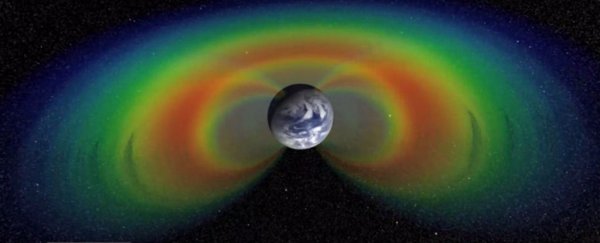More than five decades ago, scientists discovered that our planet is surrounded by two doughnut-shaped regions of charged particles, most of which originated as solar wind and got trapped in our magnetic field.
It's long been assumed that these seething regions of radiation are too dangerous for spacecraft to explore for extended periods of time, but NASA just made an unexpected discovery - the fastest, most energetic particles in the inner radiation belt are usually not even there.
Known as the Van Allen Belts, these regions of charged particles work together with Earth's magnetic field to protect us from the harsh radiation of the Sun, and tend to shrink and swell in response to how much solar wind is being blasted in our direction.
The inner belt generally stretches from around 640 to 9,600 km (400 to 6,000 miles) above Earth's surface, while the outer belt occupies an altitude of roughly 13,500 to 58,000 km (8,400 to 36,000 miles), but there is evidence that a third, temporary belt can sometimes appear.
Between the two belts is a recently discovered 'slot region', thought to be mostly devoid of particles, except at times of severe solar activity.
Back in 2012, NASA launched two Van Allen Probes to work in tandem with each other as they whiz through the radiation belts at speeds of around 3,200 km/h (2,000 mph).
The latest observations from these probes has revealed something no one was expecting - the most dangerous components of the inner Van Allen Belt, the fastest, highest-energy electrons, are more often than not entirely absent.
They did this using an instrument called the Magnetic Electron and Ion Spectrometer (MagEIS), which for the first time allowed scientists to sort particles based on their charge and energy so they could distinguish between super-fast electrons - called relativistic electrons - and high-energy protons.
Being able to separate out these two types of particles zooming through the inner radiation belt meant the Van Allen Probes team could finally get an understanding of how their populations fluctuated over time.
"We've known for a long time that there are these really energetic protons in there, which can contaminate the measurements, but we've never had a good way to remove them from the measurements until now," says Seth Claudepierre, a Van Allen Probes scientist at the Aerospace Corporation in California.
"When we carefully process the data and remove the contamination, we can see things that we've never been able to see before. These results are totally changing the way we think about the radiation belt at these energies."
Contrary to conventional wisdom, which states that the outer belt is the 'rowdy' one, growing and shrinking dramatically in response to solar activity, while the inner belt has a relatively stable composition, they found that the inner belt experiences some major fluctuations too.
They realised that rather than being filled with harsh, high-energy relativistic electrons all the time, the inner Van Allen Belt is typically made up of high-energy protons and low-energy electrons.
The reason we assumed differently was that, on rare occasions, high-energy electrons can get pushed down into the inner radiation belt by particularly severe solar storms, and it can take months, or even years, for the natural order of things to be restored.
The team looked at the energy levels of these relativistic electrons - defined as being in the range of 0.7 to 1.5 Megaelectron-volts (MeV) - and found that during a recent, incredibly powerful solar storm, high-energy particles moved in from the outer belt to flood the slot region and inner belt.
The event effectively created a whole new inner Van Allen Belt, filled with high-energy electrons:
 Purple depicts the relativistic electrons. Credit: NASA's Goddard Space Flight Center/Mary Pat Hrybyk-Keith
Purple depicts the relativistic electrons. Credit: NASA's Goddard Space Flight Center/Mary Pat Hrybyk-Keith
"We find that ∼1 MeV electrons were transported into the inner zone following the two largest geomagnetic storms of the Van Allen Probes era to date, the March and June 2015 events," the researchers explain.
"As ∼1 MeV electrons were not observed in Van Allen Probes data in the inner zone prior to these two events, the injections created a new inner belt that persisted for at least 1.5 years. In contrast, we find that electrons injected into the slot region decay on much faster timescales, approximately tens of days."
"Furthermore, we find no evidence of >1.5 MeV electrons in the inner zone during the entire time interval considered (April 2013 through September 2016)," the team points out.
The reason this is so exciting is simple - by overestimating the intensity of high-energy electrons in the inner belt, and therefore the amount of damaging radiation in low and medium altitude orbits, we've been building bulky, expensive spacecraft for no reason.
As the team points out, "At the time of writing, this is the only injection of >1 MeV electrons into the inner zone observed during the Van Allen Probes era."
Now that we know that the inner Van Allen Belt is usually a whole lot weaker than we assumed - except in extremely rare cases like the 2015 solar storms - it won't be very often that we'll have to avoid the area.
And that gives scientists the opportunity to explore our immediate cosmic backyard in ways we never even considered.
"This opens up the possibility of doing science that previously was not possible," says Shri Kanekal, a Van Allen Probes scientist from NASA's Goddard Space Flight Centre, who was not involved in the study.
"[W]e can now investigate under what circumstances these electrons penetrate the inner region and see if more intense geomagnetic storms give electrons that are more intense or more energetic."
The research has been published in the Journal of Geophysical Research.
